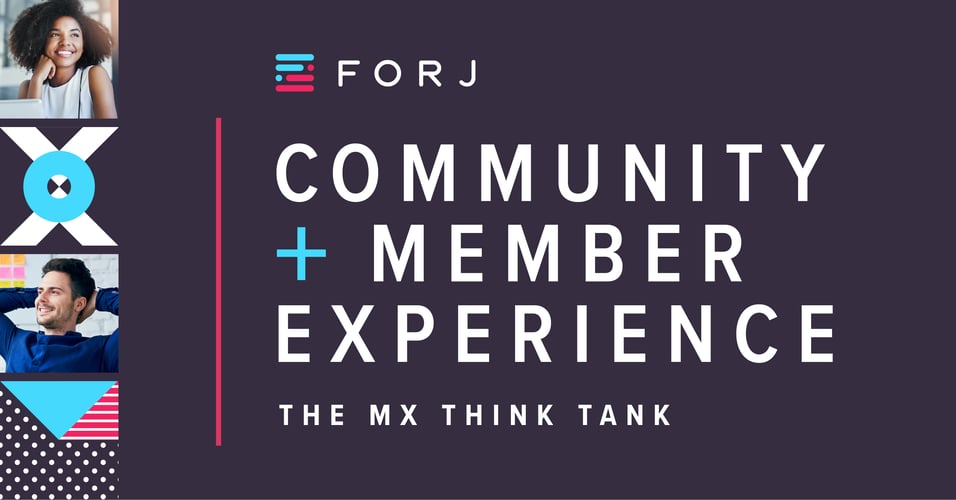
How Associations Create Connections for the Future

This fall, Forj convened a group of association leaders for an exclusive Think Tank on the intersection of community and member experience. These thought leaders came to the table to discuss their proven approach to member engagement and their ongoing community-building strategies.
At their core, associations are communities of practice custom-built to gather professionals to share, learn, and collectively advance their knowledge and interests. But that doesn’t always mean community-building happens organically, or in sustainable ways. The most successful associations make a purposeful effort to cultivate the space for communities to flourish.
There are wide and varied paths to successful community-building, but our group of executives all agreed on one thing: your journey begins with a member experience mindset. Here, we’re sharing the strategies and tactics the association leaders we spoke with believe can help you establish a sense of community today and ensure those connections last long into the future.
Community Enablers Today
Our Think Tank participants agreed that the most successful communities have members who spend time together, help each other, and contribute to the common good. Today, the best way for associations to build communities that foster these interactions is by providing always-on opportunities for members to engage. Association leaders rely on these tactics today:
- Discussions should be member-driven and organic. A highly prescriptive approach to community rarely works. Members who seek out connections and initiate organic conversations on the topics closest to them are most likely to discover value. While allowing members to take the reins and drive discussion is preferable, leaders acknowledge the need for community guidelines and etiquette that maintain a safe and productive environment.
“Our job isn’t to control conversations; it’s to make sure they happen” - Reggie Henry, Chief Information and Engagement Officer, ASAE
- Establish groups based on needs rather than demographics. It’s common for community-builders to designate groups based on members’ roles or career stages—and these types of groups can help professionals forge valuable connections. But association leaders have found that an even more effective way to gather members is by asking them to convene around problems that need to be solved. Groups coming together to tackle a shared goal will generate solutions for a more meaningful experience.
- Focus on inclusivity to foster diversity of ideas and engagement. There’s no doubt that groups with greater diversity think bigger, arrive at more innovative insights, and pioneer more creative paths forward. Association leaders are urging their staff to create inclusivity across languages, time zones, and member personas to broaden community connections. This approach also offers enhanced flexibility, which many professionals need to accommodate participation on their time and terms.
Community Enablers in the Future
As professional communities continue to grow, our Think Tank participants envision a flywheel effect of engagement that drives ongoing participation—from which revenue will follow. The best way for associations to sustain long-lasting member engagement and connections is by driving personalization to create a custom experience that can’t be matched elsewhere. Association leaders are building these strategies for the future:
- Focus on people over platforms. When you reflect on the origins of social connections, you see that community is traced to human behavior. So, rather than allowing technology to dictate the shape of your community, consider your members’ wants, needs, and desires. As they think about their communities of the future, association leaders are focused on how to anticipate and proactively meet member needs.
- Don’t just unify the experience—customize it. Everyone has the desire to break down the tech siloes that so often create barriers to engagement. But offering a seamless experience goes beyond integrating single sign-on. Association leaders are seeking systems that speak to each other, share data, and deliver insights that help them create personalization at every touchpoint and leave members feeling like “The community knows me.”
- Prioritize moments that matter. Association leaders are working hard to define the moments that matter most on their members’ journeys–especially those moments that inspire them to join and stay. Rather than relying on assumptions about why members invest their time (and dues), association leaders are seeking feedback to better understand what draws them. This enables greater prioritization and investment in the right content, events, and offerings. In some cases, our Think Tank participants said, it leads to acknowledging that you can’t do everything well and that it’s ok to cut programs that aren’t performing.
We asked our Think Tank participants how they’re designing a future ecosystem that enables a more modern and meaningful member experience. They shared an eye-opening insight that many leaders can learn from.
By and large, association technology budgets are spent on back-office solutions—many of which never touch members. Acknowledging the need for this to change, leaders are shaping their future strategy by starting with this key question: “Is it an investment for the association or for members?”
It’s a critical mindset shift that has the potential to better engage everyone—from membership to marketing—in owning the member experience of the future.

.jpg?width=5000&height=2613&name=Forj_SelectingExperiencePlatform_1200x627_NoLogo%20(1).jpg)



